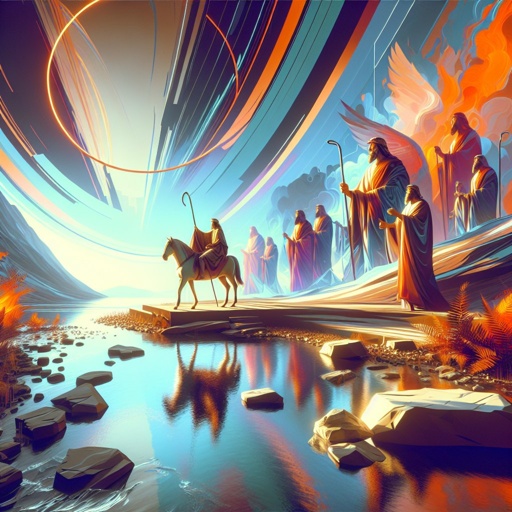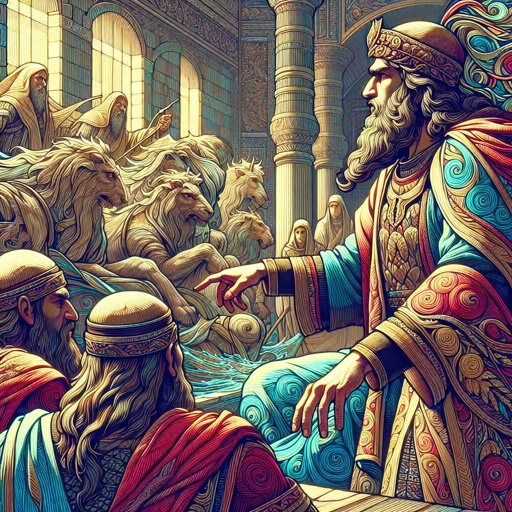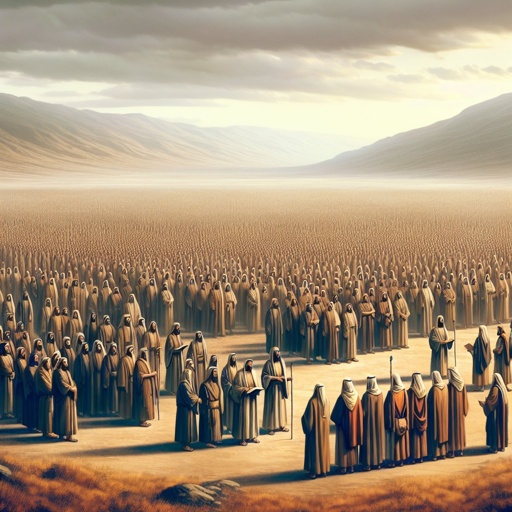What does Numbers 1:1 mean?
"And the LORD spake unto Moses in the wilderness of Sinai, in the tabernacle of the congregation, on the first day of the second month, in the second year after they were come out of the land of Egypt, saying," - Numbers 1:1

Numbers 1:1 - "And the LORD spake unto Moses in the wilderness of Sinai, in the tabernacle of the congregation, on the first day of the second month, in the second year after they were come out of the land of Egypt, saying,"
A scene that embodies the biblical verse - Numbers 1:1 - 'And the LORD spake unto Moses in the wilderness of Sinai, in the tabernacle of the congregation, on the first day of the second month, in the second year after they were come out of the land of Egypt, saying,'. Envision it set in the wilderness of Sinai, emphasizing the old weather-beaten tabernacle of the congregation. This is not just any day but the first day of the second month in the second year after they had left Egypt. The scene is completed with a divine figure, portrayed in light and energy, speaking to a humble figure representing Moses. This image is conveyed in the style of digital art.
The Bible verse 1:1 from the book of Genesis in the King James Version (KJV) states, "In the beginning God created the heaven and the earth." This verse serves as the opening statement of the entire Bible and sets the stage for the creation narrative that unfolds in the following chapters. In just ten words, this verse encapsulates the overarching theme of God's sovereignty, power, and creativity.
The phrase "In the beginning" immediately establishes a sense of timelessness and eternity that is associated with God. It emphasizes the fact that God predates all of creation and is the ultimate source of all existence. This timeless quality is reflected in many of the names for God throughout the Bible, such as "the Alpha and the Omega" (Revelation 1:8), signifying that He is the beginning and the end.
The action of creation attributed to God sets the tone for the rest of the Bible, defining His characteristics as the all-powerful and divine creator. This signifies the importance of recognizing God as the creator and sustainer of the universe, a theme that is prevalent throughout the entire Bible. The very act of creation highlights God's intention and purpose for the world, as well as His authority over it.
The specific mention of "God" in this verse sets the foundation for the monotheistic belief in the Judeo-Christian tradition. It affirms the belief in one singular, omnipotent deity who is responsible for all that exists. This verse is pivotal in establishing the foundational belief in the existence of God as the creator, which is a recurring theme throughout the Bible.
The creation of "the heaven and the earth" indicates the expansive nature of God's creation. The heaven refers to the spiritual realm, the dwelling place of God and the angels, while the earth represents the physical world and all that is contained within it. This phrase encompasses the totality of creation, emphasizing God's authority over both the spiritual and physical realms.
The context of this verse in the book of Genesis is crucial to understanding its significance. Genesis serves as the origin story of the world and humanity, providing the framework for understanding God's purpose and plan for creation. The themes of creation, sin, redemption, and covenant all stem from the foundational account in Genesis, making this opening verse paramount in setting the stage for the rest of the biblical narrative.
The symbolism within this verse extends beyond its literal meaning. The act of creation represents the divine power and authority of God, underscoring His ability to bring order out of chaos and to breathe life into the void. This imagery of creation is echoed throughout the Bible, particularly in the Psalms and the prophets, highlighting God's unrivaled creative abilities.
Additionally, the act of creation in this verse serves as a precursor to the ultimate act of redemption and restoration that is fulfilled through Jesus Christ. The New Testament reaffirms the importance of God as the creator and emphasizes the role of Jesus Christ in reconciling all of creation back to God.
In conclusion, the Bible verse 1:1 in the book of Genesis in the King James Version encapsulates the foundational belief in God as the creator of the universe. This verse sets the stage for the entire biblical narrative, highlighting God's sovereignty, power, and intention in creating the heavens and the earth. The themes of creation, divine authority, and God's overarching plan for redemption are all introduced in this critical verse, laying the groundwork for the rest of the Bible.
Numbers 1:1 Artwork

Numbers 1:1 - "And the LORD spake unto Moses in the wilderness of Sinai, in the tabernacle of the congregation, on the first day of the second month, in the second year after they were come out of the land of Egypt, saying,"

Numbers 1:7 - "Of Judah; Nahshon the son of Amminadab."

Numbers 1:15 - "Of Naphtali; Ahira the son of Enan."

Numbers 1:14 - "Of Gad; Eliasaph the son of Deuel."

Numbers 1:11 - "Of Benjamin; Abidan the son of Gideoni."

Numbers 1:9 - "Of Zebulun; Eliab the son of Helon."

Numbers 1:13 - "Of Asher; Pagiel the son of Ocran."

Numbers 1:6 - "Of Simeon; Shelumiel the son of Zurishaddai."

Numbers 1:12 - "Of Dan; Ahiezer the son of Ammishaddai."

Numbers 1:8 - "Of Issachar; Nethaneel the son of Zuar."

Numbers 34:1 - "And the LORD spake unto Moses, saying,"

Numbers 28:1 - "And the LORD spake unto Moses, saying,"

Numbers 31:1 - "And the LORD spake unto Moses, saying,"

Numbers 17:1 - "And the LORD spake unto Moses, saying,"

Numbers 13:1 - "And the LORD spake unto Moses, saying,"

Numbers 15:1 - "And the LORD spake unto Moses, saying,"

Numbers 10:1 - "And the LORD spake unto Moses, saying,"

Numbers 5:1 - "And the LORD spake unto Moses, saying,"

Numbers 6:1 - "And the LORD spake unto Moses, saying,"

Numbers 8:1 - "And the LORD spake unto Moses, saying,"

Numbers 1:48 - "For the LORD had spoken unto Moses, saying,"

Numbers 1:47 - "¶ But the Levites after the tribe of their fathers were not numbered among them."

Numbers 4:1 - "And the LORD spake unto Moses and unto Aaron, saying,"

Numbers 19:1 - "And the LORD spake unto Moses and unto Aaron, saying,"

Numbers 2:1 - "And the LORD spake unto Moses and unto Aaron, saying,"

Numbers 1:17 - "¶ And Moses and Aaron took these men which are expressed by their names:"

Numbers 1:19 - "As the LORD commanded Moses, so he numbered them in the wilderness of Sinai."

Numbers 1:35 - "Those that were numbered of them, even of the tribe of Manasseh, were thirty and two thousand and two hundred."

Numbers 14:1 - "And all the congregation lifted up their voice, and cried; and the people wept that night."

Numbers 1:16 - "These were the renowned of the congregation, princes of the tribes of their fathers, heads of thousands in Israel."